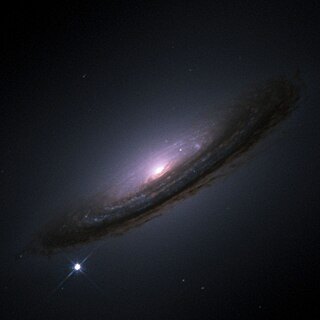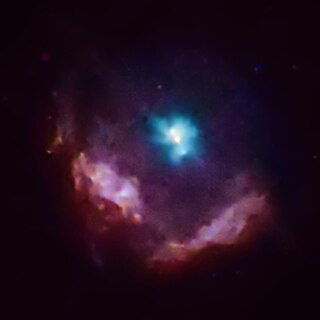Related Research Articles

A supernova is a powerful and luminous explosion of a star. A supernova occurs during the last evolutionary stages of a massive star, or when a white dwarf is triggered into runaway nuclear fusion. The original object, called the progenitor, either collapses to a neutron star or black hole, or is completely destroyed to form a diffuse nebula. The peak optical luminosity of a supernova can be comparable to that of an entire galaxy before fading over several weeks or months.

SN 1987A was a type II supernova in the Large Magellanic Cloud, a dwarf satellite galaxy of the Milky Way. It occurred approximately 51.4 kiloparsecs from Earth and was the closest observed supernova since Kepler's Supernova in 1604. Light and neutrinos from the explosion reached Earth on February 23, 1987 and was designated "SN 1987A" as the first supernova discovered that year. Its brightness peaked in May of that year, with an apparent magnitude of about 3.

A blue supergiant (BSG) is a hot, luminous star, often referred to as an OB supergiant. They are usually considered to be those with luminosity class I and spectral class B9 or earlier, although sometimes A-class supergiants are also deemed blue supergiants.

A stellar black hole is a black hole formed by the gravitational collapse of a star. They have masses ranging from about 5 to several tens of solar masses. They are the remnants of supernova explosions, which may be observed as a type of gamma ray burst. These black holes are also referred to as collapsars.

NGC 6946, sometimes referred to as the Fireworks Galaxy, is a face-on intermediate spiral galaxy with a small bright nucleus, whose location in the sky straddles the boundary between the northern constellations of Cepheus and Cygnus. Its distance from Earth is about 25.2 million light-years or 7.72 megaparsecs, similar to the distance of M101 in the constellation Ursa Major. Both were once considered to be part of the Local Group, but are now known to be among the dozen bright spiral galaxies near the Milky Way but beyond the confines of the Local Group. NGC 6946 lies within the Virgo Supercluster.

First observed between August 4 and August 6, 1181, Chinese and Japanese astronomers recorded the supernova now known as SN 1181 in eight separate texts. One of only five supernovae in the Milky Way confidently identified in pre-telescopic records, it appeared in the constellation Cassiopeia and was visible and motionless against the fixed stars for 185 days. F. R. Stephenson first recognized that the 1181 AD "guest star" must be a supernova, because such a bright transient that lasts for 185 days and does not move in the sky can only be a galactic supernova.

NGC 7424 is a barred spiral galaxy located 37.5 million light-years away in the southern constellation Grus. Its size makes it similar to our own galaxy, the Milky Way. It is called a "grand design" galaxy because of its well defined spiral arms. Two supernovae and two ultraluminous X-ray sources have been discovered in NGC 7424.

In astronomy, a Hubble bubble would be "a departure of the local value of the Hubble constant from its globally averaged value," or, more technically, "a local monopole in the peculiar velocity field, perhaps caused by a local void in the mass density."
SN 1917A is a supernova event in the Fireworks Galaxy, positioned 37″ west and 105″ south of the galactic core. Discovered by American optician George Willis Ritchey on 19 July 1917, it reached a peak visual magnitude of 13.6. Based on a poor quality photographic spectrum taken at least a month after peak light by F. G. Pease and Ritchey, it was identified as a type II core-collapse supernova.
Gliese 163 is a faint red dwarf star with multiple exoplanetary companions in the southern constellation of Dorado. Other stellar catalog names for it include HIP 19394 and LHS 188. It is too faint to be visible to the naked eye, having an apparent visual magnitude of 11.79 and an absolute magnitude of 10.91. This system is located at a distance of 49.4 light-years from the Sun based on parallax measurements. Judging by its space velocity components, it is most likely a thick disk star.
In astronomy, a calcium-rich supernova is a subclass of supernovae that, in contrast to more well-known traditional supernova classes, are fainter and produce unusually large amounts of calcium. Since their luminosity is located in a gap between that of novae and other supernovae, they are also referred to as "gap" transients. Only around 15 events have been classified as a calcium-rich supernova – a combination of their intrinsic rarity and low luminosity make new discoveries and their subsequent study difficult. This makes calcium-rich supernovae one of the most mysterious supernova subclasses currently known.

A hypernova is a very energetic supernova which is believed to result from an extreme core collapse scenario. In this case, a massive star collapses to form a rotating black hole emitting twin astrophysical jets and surrounded by an accretion disk. It is a type of stellar explosion that ejects material with an unusually high kinetic energy, an order of magnitude higher than most supernovae, with a luminosity at least 10 times greater. Hypernovae release such intense gamma rays that they often appear similar to a type Ic supernova, but with unusually broad spectral lines indicating an extremely high expansion velocity. Hypernovae are one of the mechanisms for producing long gamma ray bursts (GRBs), which range from 2 seconds to over a minute in duration. They have also been referred to as superluminous supernovae, though that classification also includes other types of extremely luminous stellar explosions that have different origins.

NGC 4424 is a spiral galaxy located in the equatorial constellation of Virgo. It was discovered February 27, 1865 by German astronomer Heinrich Louis d'Arrest. This galaxy is located at a distance of 13.5 million light years and is receding with a heliocentric radial velocity of 442 km/s. It has a morphological class of SB(s)a, which normally indicates a spiral galaxy with a barred structure (SB), no inner ring feature (s), and tightly-wound spiral arms (a). The galactic plane is inclined at an angle of 62° to the line of sight from the Earth. It is a likely member of the Virgo Cluster of galaxies.

iPTF14hls is an unusual supernova star that erupted continuously for about 1,000 days beginning in September 2014 before becoming a remnant nebula. It had previously erupted in 1954. None of the theories nor proposed hypotheses fully explain all the aspects of the object.
KIC 11145123, is a white hued star located in the northern constellation Cygnus, the swan. It has an apparent magnitude of 13.12, making it readily visible in large telescopes, but not to the naked eye. The object is located relatively far at a distance of approximately 3,910 light years, but is rapidly approaching the Solar System with a radial velocity of −136 km/s.

SN 2020jfo was a type II supernova in the Messier 61 galaxy, first observed on 6 May 2020 with an apparent magnitude of 16.01. It was one of the first supernovae for which independent, multi-instrument data was collected before, during, and after the explosion. Large astronomical surveys like Transiting Exoplanet Survey Satellite (TESS) and Pan-STARRS have played a role in data collection before and after these events.

HD 73882 is a visual binary system with the components separated by 0.6″ and a combined spectral class of O8. One of stars is an eclipsing binary system. The period of variability is listed as both 2.9199 days and 20.6 days, possibly due to the secondary being a spectroscopic binary star.

SN 2020oi was a supernova event in the grand design spiral galaxy known as Messier 100, or NGC 4321. It was discovered January 7, 2020 at an apparent magnitude of 17.28 by F. Forster and associates using the Zwicky Transient Facility. The position places it ~4.67″ north of the galactic nucleus. The supernova was not detected on an observation made three days before the discovery, and thus it must have begun during that brief period. The light curve peaked around January 13–18, depending on the wavelength, then declined rapidly over a period of 25 days before flattening into a more gradual decline. Observations of the spectrum made with the SOAR telescope showed this to be a type Ic supernova, with the progenitor being a massive star that had its outer envelope stripped. The initial velocity of the expanding photosphere was ~15,000 km/s.

Kesteven 75, abbreviated as Kes 75 and also called SNR G029.7-00.3, G29.7-0.3 and 4C -03.70, is a supernova remnant located in the constellation Aquila.
References
- ↑ Kerzendorf, Wolfgang E.; Sim, Stuart A. (1 February 2014). "TARDIS: Temperature And Radiative Diffusion In Supernovae". Astrophysics Source Code Library: ascl:1402.018. Bibcode:2014ascl.soft02018K . Retrieved 14 January 2024.
- ↑ Kerzendorf, W. E.; Sim, S. A. (1 April 2014). "A spectral synthesis code for rapid modelling of supernovae". Monthly Notices of the Royal Astronomical Society. 440 (1): 387–404. arXiv: 1401.5469 . doi: 10.1093/mnras/stu055 . Retrieved 14 January 2024.
- ↑ Harvey, L; et al. (2 May 2023). "Early-time spectroscopic modelling of the transitional Type Ia Supernova 2021rhu with tardis". Monthly Notices of the Royal Astronomical Society. 522 (3): 4444–4467. arXiv: 2304.10129 . doi: 10.1093/mnras/stad1226 .
- ↑ Vogl, C.; Kerzendorf, W. E.; Sim, S. A.; Noebauer, U. M.; Lietzau, S.; Hillebrandt, W. (January 2020). "Spectral modeling of type II supernovae: II. A machine-learning approach to quantitative spectroscopic analysis" (PDF). Astronomy & Astrophysics. 633. arXiv: 1911.04444 . Bibcode:2020A&A...633A..88V. doi:10.1051/0004-6361/201936137 . Retrieved 14 January 2024.
- ↑ Kwok, Lindsey A.; et al. (1 September 2022). "Ultraviolet Spectroscopy and TARDIS Models of the Broad-lined Type Ic Supernova 2014ad". The Astrophysical Journal. 937 (1): 40. arXiv: 2204.03716 . Bibcode:2022ApJ...937...40K. doi: 10.3847/1538-4357/ac8989 .
- ↑ Williamson, Marc; Kerzendorf, Wolfgang; Modjaz, Maryam (1 February 2021). "Modeling Type Ic Supernovae with tardis: Hidden Helium in SN 1994I?". The Astrophysical Journal. 908 (2): 150. arXiv: 2010.10528 . Bibcode:2021ApJ...908..150W. doi: 10.3847/1538-4357/abd244 .
- ↑ Kerzendorf, Wolfgang E.; Vogl, Christian; Buchner, Johannes; Contardo, Gabriella; Williamson, Marc; van der Smagt, Patrick (1 April 2021). "Dalek: A Deep Learning Emulator for TARDIS". The Astrophysical Journal Letters. 910 (2): L23. arXiv: 2007.01868 . Bibcode:2021ApJ...910L..23K. doi: 10.3847/2041-8213/abeb1b .